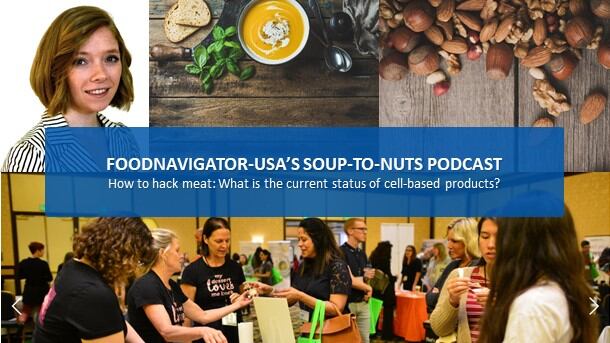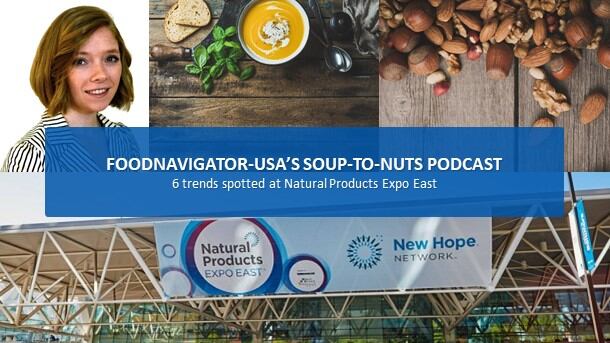In the past year, several players in the cultivated-meat (aka ‘clean’ meat or ‘lab-grown’ meat) space have offered journalists and others taste tests of the first chicken nuggets, sausages and even steaks made from cells of animals that were not harmed beyond the uncomfortable pinch of biopsy to obtain a cell line.
And while the reviews have been a bit mixed, the reality is these products exist not as a figment of the imagination, but as the soon-to-be centerpieces on plates in high-end restaurants and at foodservice.
But before that happens, companies making cultured meat, fish and poultry products must overcome several challenges related to production, pricing, consumer education and regulatory approval.
At the Reducetarian Summit in Washington, DC, late last month FoodNavigator-USA moderated a panel discussion on “The future of cellular agriculture: How to Hack Meat.” The panel included three front-runners in the space: BlueNalu CEO and President Lou Cooperhouse, New Age Meats director of operations John Pattison, and the pet food company Because Animals co-founder and CEO Shannon Falconer.
This episode of FoodNavigator-USA’s Soup-to-Nuts podcast feature highlights from that discussion, including the basics of cultivated meat, where the segment is in the innovation and production cycle, what these products could mean for the health of the environment, people and pets, the current status of regulatory oversight and when we can expect to see these products on plates.
[Editor’s Note: Don’t miss another episode of FoodNavigator-USA’s Soup-to-Nuts podcast. Subscribe on iTunes today!]
What is cultivated-meat, -poultry and -fish?
In the past few years, leading players in the cultivated- or cell-based meat segment have pushed back against calling their products ‘lab-grown’ for fear that it will conjure images of mad scientists in lab coats with Petri dishes, which could turn off consumers. Rather, they argue that their products are made in factories just like most other mass-produced food, such as chips, cereal and sliced bread.
While that may be true, the logistics of how cell-based products are made is different from other categories. At the most fundamental level it involves four core elements – cell cultures, scaffolding, media and a bioreactor or cultivator. Plus, a lot of protected intellectual property.
Falconer from Because Animals explains that the process starts with obtaining the cell cultures, which can be done through a quick biopsy that might be uncomfortable for animals but ultimately leaves them alive or from a bank of existing cell lines. Once that is done, the process of feeding and growing the cells begins.
By “combining vitamins, minerals, protein and various growth factors, you’re able to actually nourish these cells and they grow. And then eventually, depending on the type of tissue you’re working with, some of these cells … need something to adhere to in order to grow,” so in a human or animal that would be bone, but in cultured meat it is called scaffolding, she explained.
“This all sounds very simplistic. It’s not quite as easy as it sounds,” she added.
She also noted that her company obtained its cell lines from existing stores that were previously harvested for medical research, but for BlueNalu, there wasn’t a bank of seafood cells. As such, Cooperhouse said his company worked with universities to take biopsies from ‘pure’ aquacultured fish. Similarly, Pattison said New Age Meat also obtained a biopsy from a pig, which he stressed leaves the pig alive and has the potential to save millions of animal lives.
While obtaining the cell lines sounds difficult and expensive, it is nothing compared to replicating them and actually creating meat. In fact, Pattison said the biggest challenges facing New Age Meats is developing the medium inputs and scaling production. However, he notes, that where possible the company and segment are partnering with players in adjacent areas that might have solutions.
Building a regulatory framework
Another challenge currently holding back the segment is determining the best way to regulate cell-based products and ensure their safety.
At the end of last year, FDA and USDA ended their turf war over which would have primary jurisdiction over cell-based products and decided that they would share oversight, a decision that Pattison says many players are happy with, but he notes there are still a few kinks to work out.
Cooperhouse also lauded the agencies’ joint approach to overseeing the production of these products, because he said ensuring safety is paramount for the category’s long-term success. As such, he added that his company follows many existing regulations that apply to conventional animal products, such as developing a Hazard analysis and critical control points, or HACCP plan.
Cooperhouse added that as regulators and industry continue to hash out oversight of cell-based products, industry players need to continue to go to FDA, USDA and other regulators early and often to ensure everyone is on the same page and headed in the right direction.
While there is a lot of wiggle room for how the regulatory framework could shake out, Cooperhouse and Pattison agreed that if all goes well on the regulatory-side they should be able to have their products on plates in restaurants and foodservice in two to three years. Retail, however, might take a bit longer, they added.
Why bother with something so complicated as cultured meat?
Between the challenges with production and scaling and navigating regulatory oversight, it is safe to say that bringing cell-based products to market is hard. And this begs the question – why bother? For the panelists the answer came down to animal welfare, environmental health, human health and economic development.
While animal welfare is a given in that cell-based products offer animal products without slaughter, the environmental impact is a bit more nuanced, as Pattison explained.
“When we looked at the environmental impact, everything that we're seeing is driving us down, right? So, if we can transition to cultivated meat and you look at pork earlier than the million animals that are harvested in and raised, we can reduce usage by 99% energy consumption by half, greenhouse gas emissions by over 9%. So yes, do we still have an impact on the environment? Of course, because unless you just sit the box all day, you're going to have some impact. But we can really reduce that impact significantly. And that's really exciting,” he said.
Falconer echoed these comments, adding that quarter of the environmental effects of factory farming, including animal agriculture, are directly attributed to products that Americans feed their cats and dogs.
Beyond the environmental impact, Cooperhouse said cell-based products also offer nutritional benefits to humans by offering them an exact replica of the nutrition they’d receive from animal products, but without some of the contaminants that are increasingly common. For example, he noted cell-based production could lead to mercury-free tuna and fish without bioplastics.
He explained the industry also provides an added layer of food security by reducing reliance on imports, which would also create jobs in the US.
Industry needs help from NGOs
With so many factors to balance and a lot of lingering questions by consumers, regulators and potential investors about the process of cultivating cells and producing finished products, industry players are asking for help from non-profits.
In particular, Pattison said that NGOs are well positioned to help raise funding for research and advocate to a variety of stakeholders.
Cooperhouse echoed many of these points and also stressed the need to educate mainstream consumers and younger generations about the potential of this technology and the impact they could have on the environment by choosing cultured-cell products over animal products.




